- 26 Wyoming Facts: Fun Facts About Wyoming You Need To Know - October 31, 2023
- 26 Utah Facts: Fun Facts About Utah To Read Now - October 25, 2023
- 26 Idaho Facts: Fun Facts About Idaho To Read Now - October 24, 2023
Many things make this Utah National Parks Road Trip a must on any avid traveler’s bucket list!
Maybe it’s the dramatic red rock landscapes that will make you feel like you’re walking on Mars, the whacky-looking rock formations that pierce the sky, the unparalleled hiking opportunities, and the adventures through the desert.
If you’re currently in the plotting stages of your Utah Mighty 5 road trip, chances are you’re feeling super overwhelmed trying to fit everything in.
Whether you’ve already decided to focus on the state’s national parks or are simply looking for a truly epic guide, we’ve put together the ultimate 8-day itinerary so you can relax and simply focus on enjoying the scenery rather than planning!
Starting in Salt Lake City or Las Vegas (whatever works better for you), this road trip through Utah will have you exploring the contrasting scenery of Zion National Park, traversing the sweeping canyons of Canyonlands National Park, gawking at massive natural arches at Arches National Park, and so much more!
The Best Time to Go on a Utah National Parks Road Trip
Even though you can do this Utah national parks itinerary any time of the year, it’s important to remember that the weather changes can get pretty drastic.
As a rule of thumb, the best time to go on a Utah road trip is either in spring or fall, as both seasons bring in excellent weather.
The downside to spring is that the national parks get pretty crowded for that very same reason, so if you’re the type of traveler who prefers a bit more solitude, then fall is your go-to!
Avoid planning a Utah national parks road trip during the summer vacation at all costs, especially if you’re keen to do some hiking.
Most parks get scorching hot, making hiking a true challenge (we’re talking temperatures over 100 degrees!). Also, three of these parks are among the most visited national parks.
If you don’t mind the cold, winter is also another lovely time to visit. Crowds become almost non-existent.
While it’s not a guarantee, you may even get to see snow at some of the parks – the red tones look absolutely stunning when contrasted with white!
Temperatures during the day are bearable if you bring the right gear, but nights do get pretty chilly, so make sure you prepare for that!
Where to Stay on Your Mighty 5 Utah Road Trips
- Zion National Park: Zion Lodge
- Bryce Canyon National Park: Best Western Plus Ruby’s Inn
- Capitol Reef National Park: Capitol Reef Resort
- Arches National Park: Fairfield Inn Moab
- Canyonlands National Park: Fairfield Inn Moab
How to Get Around
Harry Reid International Airport in Las Vegas is 167 miles from Zion National Park or a 3-hour drive. Alternatively, you can also land at Salt Lake City International Airport, but this one is a bit farther away: a 4.40-hour drive.
(Unless you want to start your road trip in Arches. Its visitor center is only three and a half hours southeast of Salt Lake City’s airport.)
Either way, the best way to get to the park from the airport is by car. You can choose from several rental car companies and snag good deals at Discover Cars.
Admission to Utah’s Mighty 5
Before you pack your bags, roll down your windows, and venture out on this incredible Utah road trip, we strongly advise you to buy the America the Beautiful Pass to save quite some money.
This pass covers entrance fees for a carload of people or up to 4 adults (depending on whether the park charges admission per person or vehicle).
To give you an idea of how much you can save, here are the entrance fees for Utah Mighty 5 for a private vehicle:
- Zion National Park: $35
- Bryce Canyon National Park: $35
- Capitol Reef National Park: $20
- Arches National Park: $30
- Canyonlands National Park: $30
- TOTAL: $150
However, the national park pass gives you access to all parks above (plus all the rest of the National Park Service) for only $80. That means the pass saves you $70!!
Don’t miss out! Click here to buy your national park pass!
Tips for Your Utah National Parks Road Trip
- Book ahead: always book accommodation early to snag better deals. Many attractions, including national parks, are crowded these days, so the demand for nearby lodges is high. We use Booking.com and Hotels.com to book our lodging because of their easy cancellation policies.
- Buy the pass: the national park pass can save you a nice amount of money, not only on this road trip but on any other trips to national parks you will make within 12 months. It’s a no-brainer!
- Get up early: you’ll want to arrive early at the national parks to avoid the crowds. Remember, the early bird catches the worm!
- Bring plenty of water: it’s crucial to stay well-hydrated, so pack enough water for each hike (as well as snacks and sun protection).
Utah National Parks Road Trip Itinerary
Here’s our itinerary for a road trip to Utah national parks (Utah Mighty 5 road trip):
Day 1: Drive from Las Vegas (or Salt Lake City) to Zion National Park
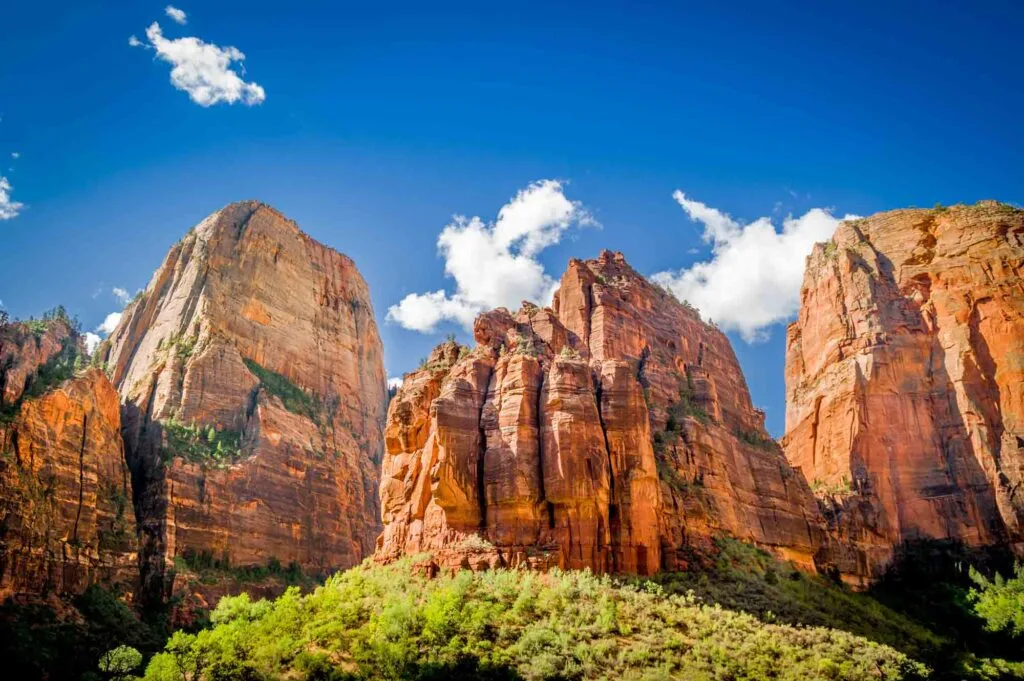
Day one is all about getting from the airport (Las Vegas or Salt Lake City) to the starting point of your Mighty 5 road trip: Zion National Park.
This gem of a park is a wonderland of soaring cream and red-toned cliffs, a congregation of desert wildlife like no other, hanging gardens, striking rock formations, hidden grottos, and lush meadows above mesa tops.
Zion National Park’s unique contrast in landscapes makes it a truly unique place to visit on a Utah national parks road trip, and there’s a little something for everyone, no matter the type of trip you’re planning.
If you’re into hiking, you’ll find plenty of trails all over, many of which you can also explore on a bike if you wish to.
Scenic driving is also a dream here, and thanks to the park’s brims with Native American history, you’re also guaranteed to leave with a lot of newfound knowledge!
When you arrive at Zion, visit the Zion Human History Museum, where you’ll get a pretty well-rounded introduction to the indigenous Paiute who once inhabited the area.
As you leave, you’ll find some of the most iconic rock formations in Zion right outside the museum (including the Watchman and the Tower of the Virgin). Take both the museum and these sights as a window of what’s coming next!
- Drive time from Salt Lake City to Zion National Park: 5 hours
Where to Stay in or near Zion National Park
There are three campsites available within the park. If you’d like a bit more comfort, you can find a few accommodation options nearby.
For glamping-style tents, you may want to go to Zion Wildflower Resort, or if you’re going to stay in the park, check out the Zion Lodge!
Day 2: Zion National Park
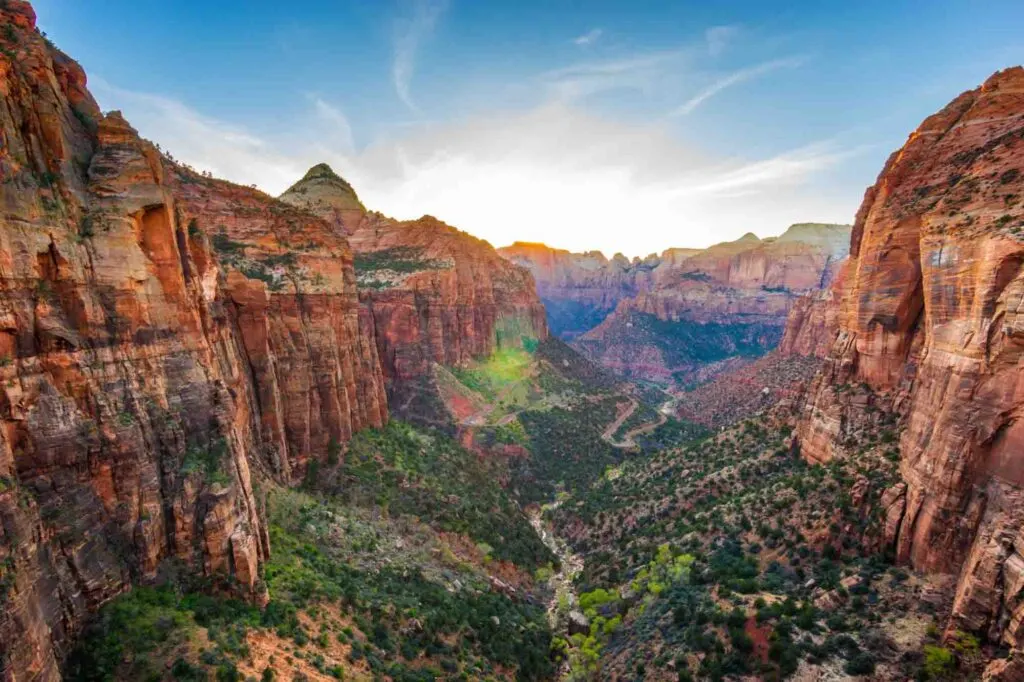
After learning about the Pauite people to understand better the land you’re walking on, tie up your shoelaces and head out to explore the park on foot.
Most of the trails at Zion National Park are pretty short and sweet, so you’ll be able to kick several of them in just a few hours.
- Canyon Overlook Trail: A super easy hike that will take you to a viewpoint that overlooks Zion Canyon. (1 mile)
- Emerald Pool Trail: This trail will lead you to beautiful natural pools, Lower Emerald Pools, and Upper Emerald Pool. (3 miles)
- Riverside Walk: A super flat trail that follows the Virgin River and ends near the Narrows. (2.2 miles round trip)
- The Watchman Trail: A short trail that heads up to a viewpoint on the cliffs above the canyon floor. This trail doesn’t take you to the top of Watchman Mountain, but you’ll be able to get a pretty clear view of it! (3 miles round trip)
After exploring Zion National Park’s trails, it’s time to find the best spot in the park for a seriously epic sunset.
Hop on your car and drive to Kolob Canyon, a relatively unknown park section.
Here, you’ll find the trailhead to Timber Creek Overlook at Kolob View Point, where you’ll get the most awe-inspiring 360-degree views of the surrounding rock formations and, on a clear day, you may even get a glimpse of the Grand Canyon’s North Rim section!
Where to Stay in or near Zion National Park
Attractions Near Zion National Park
These attractions are within drivable distances from Zion, but keep in mind you might need extra days to visit them.
- North Rim Grand Canyon
- Lake Powell
- Sand Hollow State Park
- Snow Canyon State Park
- Valley of Fire State Park
- Kodachrome Basin State Park
- Coral Pink Sand Dunes State Park
Day 3: Zion National Park & Drive to Bryce Canyon National Park
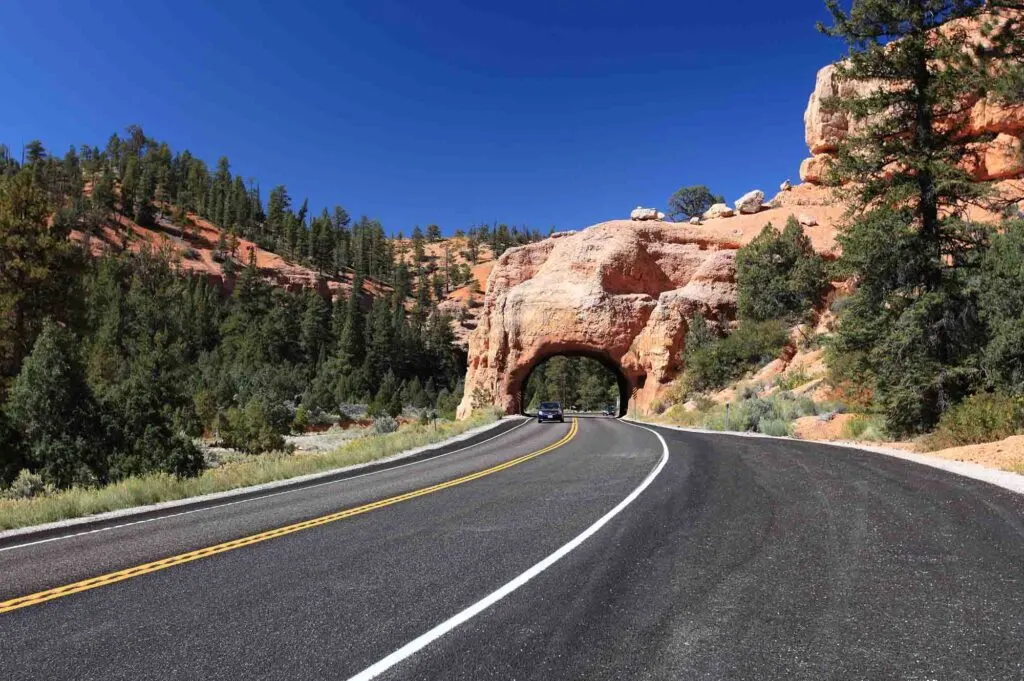
Day three will have an early start as it’s a pretty action-packed one! If you’re up for a challenge, you can fit in the Angels Landing hike to end your time at Zion National Park in a truly epic way.
Angels Landing is by far the most popular trail in Zion, so you need a permit now. The hike is pretty strenuous and usually takes around 4 hours to complete (although it may take 3 hours if you’re experienced).
The hike starts at the Grotto Trailhead and follows the West Rim Trail to take you to a superb viewpoint that stands 1,500 feet above the canyon floor.
In addition, this hike is guaranteed to test your skills, so if you don’t consider yourself experienced enough or are afraid of heights, you can do a short walk instead or have a lazy morning.
Some More Favorite Hikes in Zion National Park Worth Checking Out:
- Scout Lookout via West Rim Trail – challenging
- Observation Point via East Mesa Trail – moderate
- Pa’rus Trail – easy
Pssst: You can also give your legs a break and go on the 12.6-mile Zion National Park Scenic Drive!
After some serious desert hiking, it’s time to head to Bryce Canyon National Park, where you’ll be greeted with a sea of striking red rock hoodoos.
Bryce Canyon happens to be home to the most extensive collection of red rock hoodoos in the entire world, so right there is all the inspiration you need to convince yourself to drive over.
Once you arrive, the first thing you’ll want to do is drive Highway 12, a scenic route that cuts right through the park and provides some of the most scenic viewpoints that will give you a pretty well-rounded introduction to some of the most iconic vistas here.
For sunset, head to Sunset Point, where you’ll get the chance to see the sun go down over an amphitheater of red rock hoodoos, an experience like no other and the most epic way to end the third day of your Utah National Parks road trip.
- Drive time from Zion National Park to Bryce Canyon: 1 hour and a half
Where to Stay near Bryce Canyon
Most people stay in Bryce, just a few minutes’ drive from Bryce Canyon’s park entrance.
More Attractions in Bryce Canyon National Park
- Sunrise Point: arrive at dawn to take in the last few minutes of the starry night sky
- Rainbow Point: beautiful views from the highest point in the park. Rainbow Point is one of our favorite vantage points in Bryce Canyon.
- Fairyland Point: epic views of hoodoos, natural bridges, and more.
- Bryce Point: Bryce Point is a must-see highlight within Bryce National Park. It gives panoramic views of a massive amphitheater of red rock formations and grottoes long ago carved out by ancient rivers.
Day 4: Bryce Canyon & Drive to Capitol Reef National Park
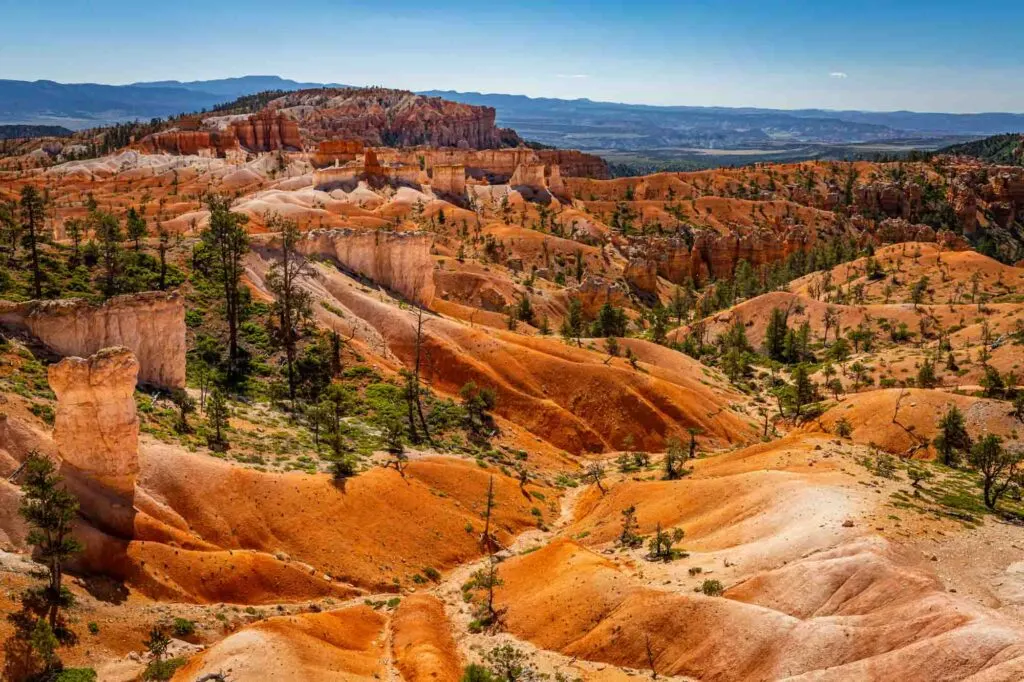
Today, we’ll be getting more personal with Bryce Canyon and the Bryce Amphitheater area.
As we’ve mentioned before, bright red hoodoos make Bryce Canyon’s landscapes such a treat, and one of the best trails to see them is the Queens Garden to Navajo Loop Trail.
Throughout the hike, you’ll be weaving your way through rock tunnels, red rock limestone walls, and pine forest.
You’ll also get access to some of the best lookout points in the park and stand in front of unparalleled vistas of the sandstone hoodoos that make Bryce Canyon so strikingly beautiful.
This loop is a combination of two different trails. We recommend hiking it clockwise, starting at the Queens Garden Trail before going up the Navajo Loop Trail.
After hiking the Queens Garden Trail, you may have some time to spare to explore further afield. You can pick from the many short hiking trails on offer. Here are a few for you to choose from:
- Mossy Cave Trail: A hike that feels more like a stroll into a world of pinnacles before ending at a small cave covered in moss. (0.8 miles)
- Navajo Loop Trail: A loop from Sunset Point that will take you down to the floor of Bryce Canyon. This trail passes some of the most iconic formations in the park, including Twin Bridges, Thor’s Hammer, and Wall Steet. (1.4 miles)
- Bristlecone Loop Trail: A pretty sweet loop above the canyon rim. As you hike, you’ll get to traverse a subalpine forest and see lots of bristlecone pine trees, the oldest tree species in the world! (1 mile)
Once you’re back, leave Bryce Canyon National Park and drive two hours to Capitol Reef National Park.
Get a good night’s sleep here to gear up for another day spent adventuring in the desert!
- Drive time from Bryce Canyon to Capitol Reef: 2 hours
Where to Stay in Capitol Reef National Park
There are campsites available within Capitol Reef National Park. Alternatively, you can stay at the Capitol Reef Resort, located right at the doorstep of the park’s entrance and provides several lodging options ranging from guestrooms to luxurious cabins and even Conestoga wagons and teepees!
Day 5: Capitol Reef National Park
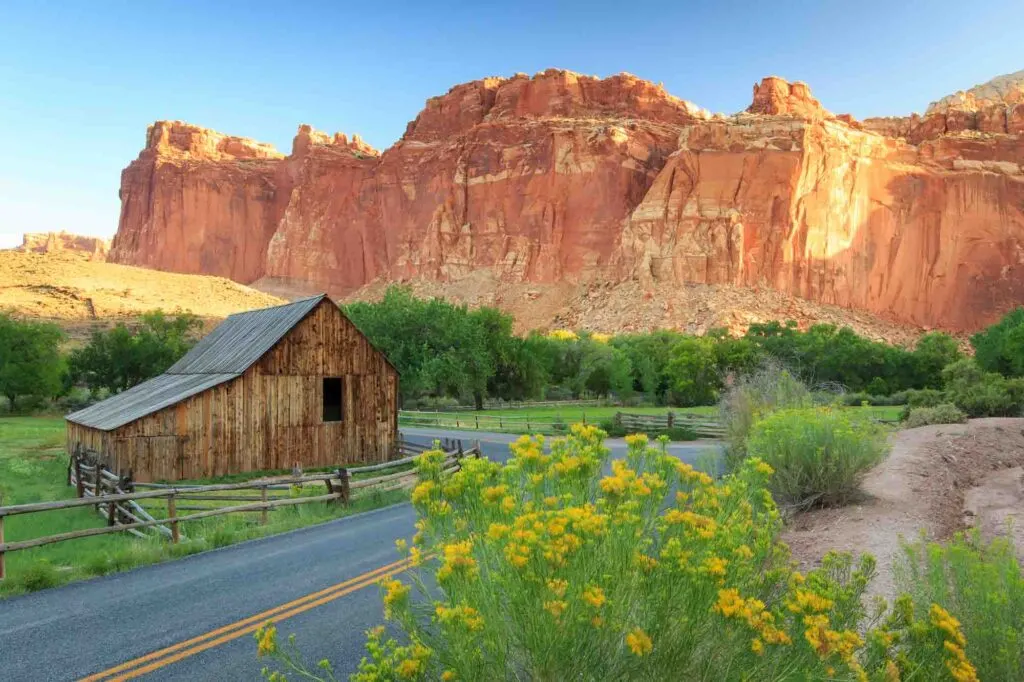
Today, we’ll be exploring Utah’s most underrated national park.
Capitol Reef is a little less popular than the other ones in this Utah national parks itinerary, but trust us when we tell you you’ll be in for a real treat!
What makes the landscape at Capitol Reef National Park so insanely unique among the rest of the national parks in Utah is the Waterpocket Fold, a “wrinkle” on the surface of the earth that was formed millions of years ago.
This warp created a dramatic landscape of rugged canyons, massive cliffs, and striking rock formations that will make you feel like you’re on Mars.
After breakfast, start your day by hiking your way to Hickman Bridge, a classic 2-mile hike (round trip) that will have you seeing some of the most emblematic landmarks in Capitol Reef National Park.
After hiking, rest your legs by hopping on your car and driving down Highway 24, which will allow you to check out a unique petroglyph panel. These petroglyphs provide an excellent insight into the indigenous people that once called the area their home.
Next, drive along the park’s 8-mile long scenic road, which provides access to unparalleled viewpoints as well as some of the most symbolic sights in Capitol Reef.
Depending on how much energy you have left, you can wrap up your visit by hiking to Cassidy Arch, which takes just under 2 hours to complete and ends at one of the most iconic spots in the park (and a perfect place to watch the sun go down!).
Where to Stay in Capitol Reef National Park
More Attractions in Capitol Reef National Park
- Panorama Point: viewpoint with beautiful views over Highway 24
- Goosenecks Overlook: easy round trip to a stunning overlook
- Sunset Point: easy round trip to THE perfect spot to catch a sunset at Capitol Reef National Park
- Fruita and Cathedral Valley Districts: historical district and remote, rugged scenery with beautiful views.
Day 6: Drive to Arches National Park
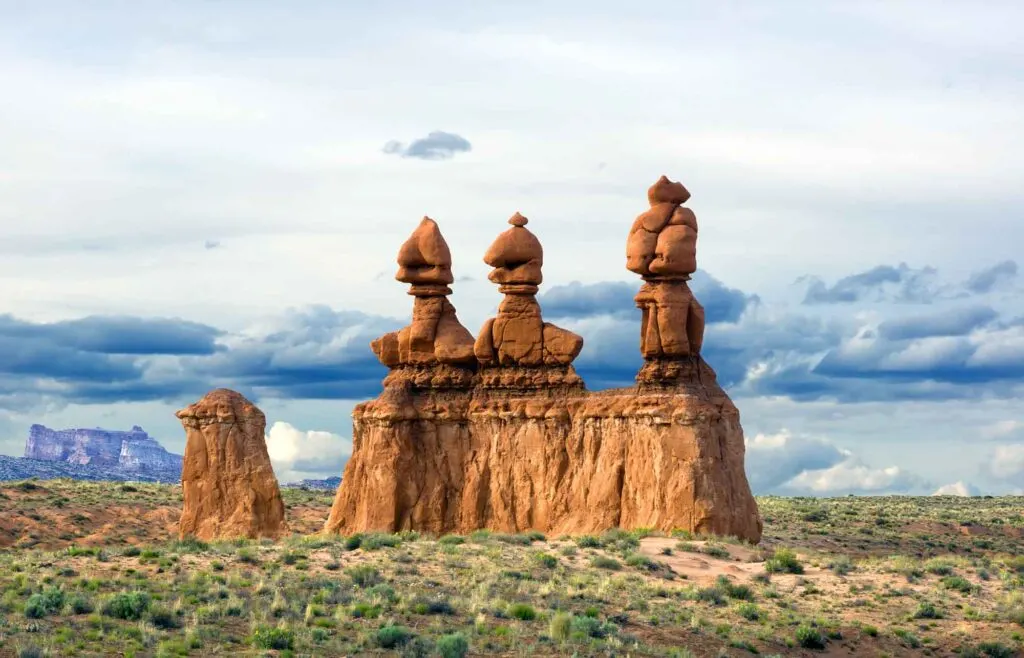
Today, you’ll drive to Arches, but on the way there, you might want to make a stop at Goblin Valley State Park for massive mushroom-like sandstone formations. It’s an incredible sight!
Moving on to Arches, the park is home to over 2,000 natural arches and a variety of whacky-looking rock formations, meaning a visit to Arches National Park is an experience like no other.
Thanks to the fact that the park is relatively small, it’s pretty easy to check out the top highlights (Skyline Arch, Sand Dune Arch, Broken Arch, and more) quickly.
Your legs will probably be pretty tired at this point, so we’ll take things slowly today.
Hop on your car to drive down the Arches Scenic Ride, which provides access to some of the best viewpoints in the park, to get a pretty well-rounded introduction to what it has to offer.
For an epic sunset at Arches National Park, head to The Windows, which you can find by hiking the Double Arch Trail and detouring a bit at the very end – here, you can find yourself a cozy spot with a bit more solitude than the more popular Delicate Arch!
- Drive time from Capitol Reef to Arches National Park: 3 hours
Where to Stay in Moab
Devils Garden Campground is the only campground available in Arches National Park, so it may be difficult to snag a spot.
For more lodging options, you’ll need to head to the closest town of Moab, which is only 10 minutes away.
Once in Moab, you’ll find plenty of options for every budget. The Fairfield Inn Moab is located right by the entrance of Arches, or you can stay in the center of town to be close to amenities (Hoodoo by Hilton or Cottonwoods 57 are both excellent choices).
Day 7: Arches National Park
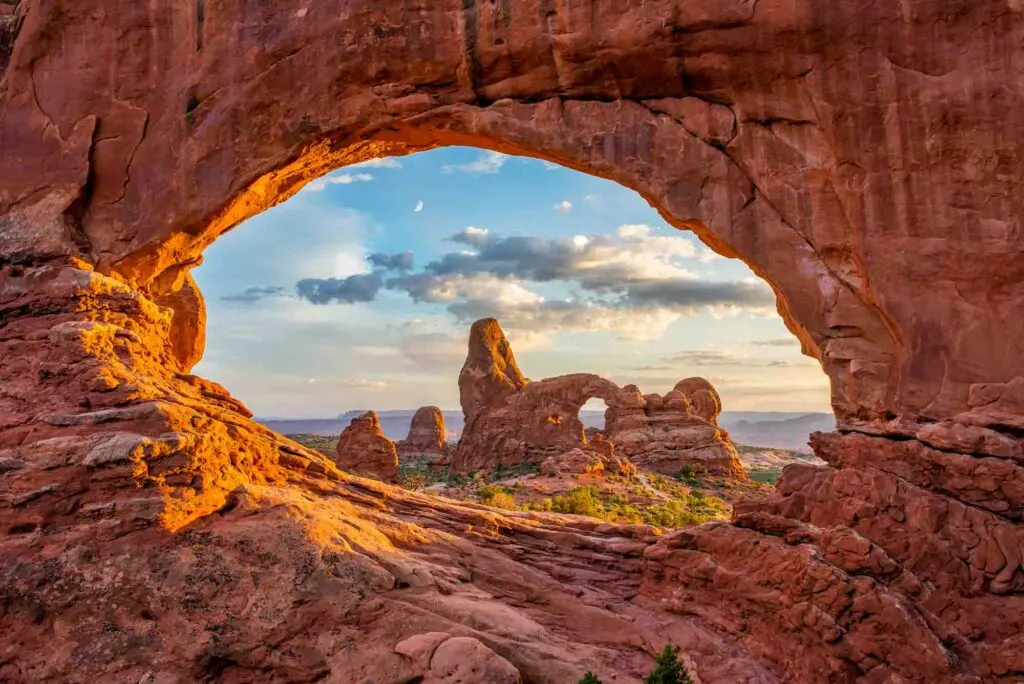
In 2022, you need a timed entry ticket for Arches.
To start the day at Arches National Park, hike for 1.5 miles to Delicate Arch, one of the most iconic landmarks in Utah (so much that Delicate Arch is featured on the state’s license plates!).
As a spectacular sunrise spot, expect to share the views with many people, so try to get there as early as possible.
After experiencing the most epic way to start a day, it’s time to see the largest natural arch in the world: Landscape Arch.
To get there, you’ll need to hike for about an hour. The trail begins in the Devil’s Garden area of the park, where you’ll find many other formations to check out in case you want to extend your hike.
After Landscape Arch, you’ll have some time to spare to explore further afield. There are many easy (and absolutely epic) day hikes to tackle. Here are a few for you to choose from:
- Balanced Rock: A super short hike that will take you to Balanced Rock, a super unique rock formation that stands above the crowds at Arches because it’s not, well, an arch! (0.3 loop)
- Double Arch: A trail that will take you to two massive arches that share the same rock as a foundation (they’re the tallest in Arches National Park!) (0.6 miles)
- Tower Arch: A moderate hike that’s perfect for those who would rather stray from the crowds. The trail is pretty rugged, but the views of Tower Arch and the Klondike Buffs make it worth it! (3.4 mikes)
Tomorrow you’ll be visiting Canyonlands National Park, close to Moab, so there is no need to change lodging.
Where to Stay in Moab
More Attractions in Arches National Park
- La Sal Mountains Viewpoint: panoramic view of the La Sal Mountains and Arches National Park
- Garden of Eden: lots of hoodoos and sandstone rock formations
- Park Avenue Trail: easy and short hike with epic views
- Fiery Furnace: beautiful views of non-arch landscapes
Day 8: Canyonlands National Park & Las Vegas (Or Salt Lake City)
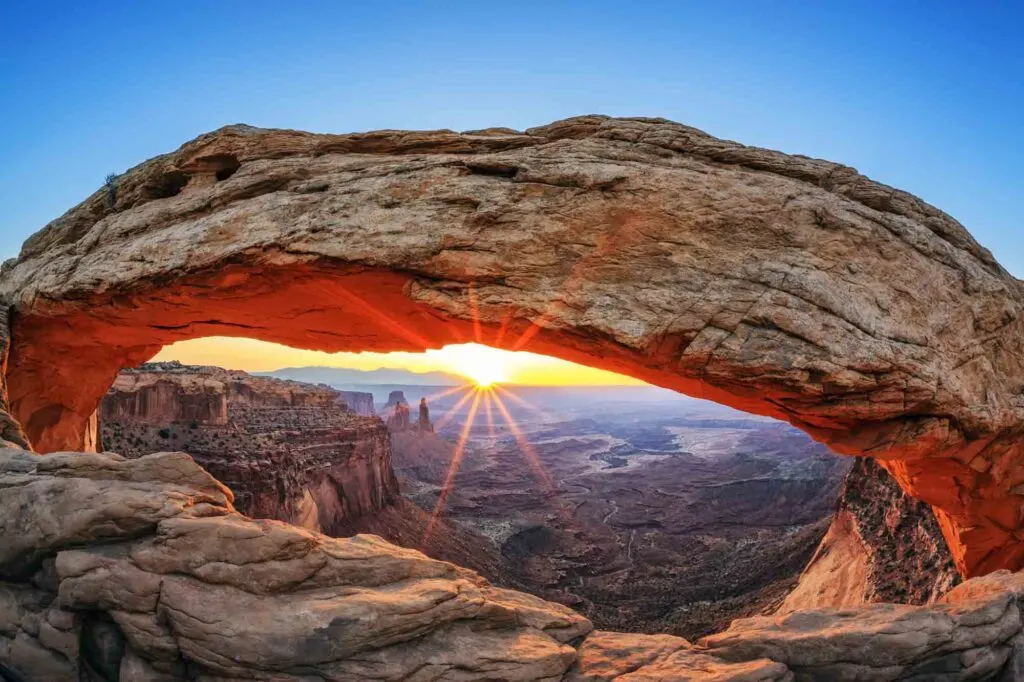
Sweeping canyon views that seem to last forever, Mars-like landscapes, and striking red rock formations that look as though they pierce the skies – that’s Canyonlands National Park in a nutshell.
Because the park is massive, you could virtually dedicate an entire year to exploring it and still not get to cover it completely.
Since we only have a day at Canyonlands National Park, we’ll focus our time on exploring the Island in the Sky district. This section is the most frequently visited one of Canyonlands National Park and where you’ll find the most iconic highlights.
Hike the short trail to Mesa Arch to greet the day as soon as you get to Island in the Sky.
Make sure you start hiking right before sunrise to get there just in time to see the sun rising directly underneath the arch, creating a landscape that looks like it belongs in a painting!
Next, choose from a few of the hiking trails on offer. The trails here are relatively short and sweet, so you’ll get enough time to cover quite a bit of ground in just a few hours.
- Upheaval Dome: It is a pretty entertaining trail that ends at a whacky-looking landmark whose colors contrast with the cliffs. No one knows exactly how this strange dome was created, but it sure is pretty to look at! (1.3 miles)
- Aztec Butte Trail: A moderate trail to Aztec Butte, a rock outcropping that boasts spectacular 360-degree views of Island in the Sky. (1.6 miles)
- Murphy Point Trail: A pretty gentle trail that will take you right to the edge of the canyon, where you’ll get sweeping views of the White Rim Canyon. (3.6 miles)
- Grand View Trail (one of the most popular trails at Canyonlands National Park): This trail leads to the southern tip of Island in the Sky and provides epic panoramic views of the White Rim and the river canyons below. (1 mile)
- Whale Rock Trail: A short and easy path to Whale Rock. Along the route, you’ll ascend the slick rock slope of a sandstone outcrop, which provides incredible vistas of the dome. (0.8 miles)
- White Rim Overlook Trail: This trail provides the most striking views of the White Rim as well as Monument Basin and Gooseberry Canyon. (0.9 miles)
After hiking, drive the main road that serves the district to Upheaval Dome. This short but highly scenic drive is just around 34 miles round trip, but it will have you hitting all the main viewpoints of Island in the Sky in one go!
For a truly epic sunset, make your way to Green River Overlook (a 15-minute drive from Syncline Loop Trailhead), which provides sweeping vistas of the canyons that look even more strikingly beautiful when the last rays of sunshine on the walls and make the rocks pop with bright colors!
Ahh, isn’t Canyonlands National Park incredible?
From here, start making your way to Las Vegas (about 7 hours) or to Salt Lake City (about 4 hours) to catch your flight back home!
- Drive time from Arches National Park to Canyonlands National Park: 30 minutes
Pssst: Dead Horse Point State Park is right next to Canyonlands National Park.
Summary of Your Utah National Parks Road Trip
Be sure to bookmark this page so you can easily find information while planning your trip.
- Day 1: Drive from Las Vegas (or Salt Lake City) to Zion National Park
- Day 2: Zion National Park
- Day 3: Zion National Park & Drive to Bryce Canyon National Park
- Day 4: Bryce Canyon National Park & Drive to Capitol Reef National Park
- Day 5: Capitol Reef National Park
- Day 6: Drive to Arches National Park
- Day 7: Arches National Park
- Day 8: Canyonlands National Park & Las Vegas (Or Salt Lake City)
Map Utah National Parks
The map below shows the route from Las Vegas to Zion National Park and beyond. Still, if it’s easier for you, you can kick off your road trip in Salt Lake City and then head south to Zion National Park.
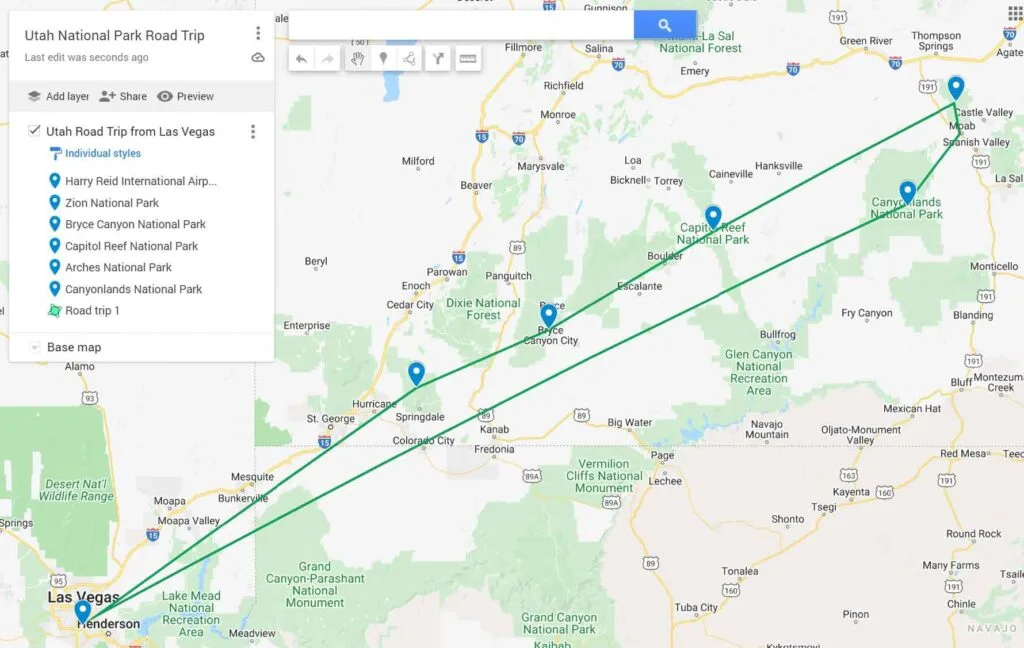
FAQ About the Mighty 5
What is the might 5 in Utah?
The mighty five are all five national parks in Utah, known for their striking natural beauty: Arches National Park, Bryce Canyon National Park, Canyonlands National Park, Capitol Reef National Park, and Zion National Park.
Which of the mighty 5 is the best?
That’s a difficult question! Each of Utah’s national parks has its unique features and colorful scenery. Still, Zion is Utah’s first national park, established in 1919, and ranks as the state’s most-visited park today.
How many days do you need for the mighty 5?
The more, the merrier. Still, we know vacation days are limited, and that’s why we recommend 8 days for this Utah national parks road trip.
Final Thoughts on this Road Trip to Utah National Parks
Among the best scenic drives, iconic hikes, beautiful red rock canyons, and spectacular viewpoints in the United States—that’s a shy summary of this fantastic Utah road trip.
We hope this Utah National Parks road trip helped you plot the perfect itinerary for your trip.
Planning a route is a pretty difficult feat when it comes to going on a Utah road trip because there’s so much to do.
If it’s your first time, though, focusing on its national parks is a pretty darn good way to get introduced to the best the Beehive State offers in terms of natural goodness!
Are you currently plotting a national parks road trip through Utah? I’d love to know which one you’re most excited about visiting, so let us know all about your plans in the comment section below!

Brenda Bursack
Monday 18th of September 2023
We are looking at taking a trip to Utah mid-March and are looking for an itinerary for the Grand 5 and recommendations on where to stay. We are looking at flying to Vegas and driving to Salt Lake City or vice versa.